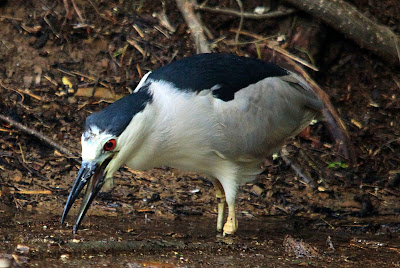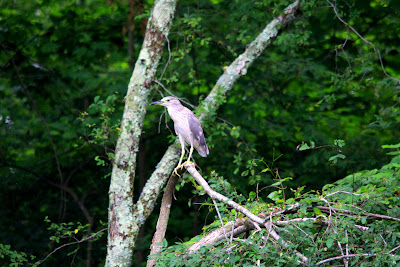Shade and I just rounded the corner of an island and came up on a tiny notch in the shoreline that I threw the binoculars upon. The black crowned night heron landed near a marshy area full of debris. I found him totally by accident and he never saw me.
The great thing about this opportunity to photograph this night heron is that he was not apprehensive at all. He sensed no danger and certainly didn't see me or the boat.
These shots provide a good opportunity to study some points about the bird. One thing that stands out is how big his feet are. They act as platforms that provide balance when the bird moves over rough terrain. He can walk on uneven, muddy shorelines and dart after prey in any direction with precision due to the ultra stable confidence his overlarge feet provide. If you could see a heron on the limb of a tree you'd see his long, long toes matching the contours of the limb he is standing on.
He is preparing to stick his beak into the mud and search for food. I'm surprised to see him do this. I know they are sight feeders but I wasn't aware they would sweep their beak through soft mud to make contact with food critters.
Look at the two long strands of feathers (plumage) that sweep back off the rear of his head. He's a handsome fellow.
These herons are opportunistic feeders. They will eat fish, frogs, lizards, salamanders, small rodents, bird eggs, large insects and even snakes.
He found something but had it down his throat before I could see what it was. These birds grab prey with it's beak and do not "spear" it like his green heron cousin does at times.
He's stepping out. Look at those big feet!
He suddenly stopped in his tracks and looked directly in my direction. I've been found out. He left the ground in a burst of speed. It happened so fast I missed the shot. I did get a poor quality image of him taking off. I wasn't ready. The lens was set at 500 mm (too much magnification). It was really dark back under the trees and the shutter speed was, I think, 1/400th of a second. That's way, way too slow for action images. But here's the botched photo of his launch.
Watching this guy back in this cove was really exciting for me. It's very desirable to catch wildlife off their guard. They can be observed going about their daily routines without the influence of potential lurking danger.
I didn't even get the boat started when another heron landed in a tree. I won't dwell on this one other than to say he's a bit on the lean side. I believe him to be a younger heron. His color isn't vivid yet which further indicates he is a young bird. Remember, immature are solid blond and transition to shades of blue as they age. I did get a fair shot of his outspread wings from the back of him. Look at that really pretty pattern on his back.
The boat was rocking like mad. I discarded the other shots of this heron due to blurriness.
This has been an exciting few moments. If you were a birder you'd understand. We finally got the boat moving again. I have to admit that I stopped for about ten minutes to get these shots. I could go another year and not see another one.
I put a lot of photos of the heron in this entry because it's an important bird to me. Now - to a different bird. The cormorant in the shots below has caught a catfish. The problem is that the fish is too large for the bird. Cormorants swim just as well as fly and can run down most any species of fish under water. That all aside. He had his beak full of problems with this fish.
The boat was rocking and clouds blocked a lot of the sun. Again, these shots required faster shutter speed, but the shots came out OK.
Isn't this fascinating?
That's all I could come up with today. I'm off tomorrow and I'm not sure what I'll be doing because hard rain is being predicted. Hope you enjoyed the night heron shots. Thanks for being a reader. I appreciate it.




































No comments :
Post a Comment
I appreciate your interest in my blog and welcome your comments